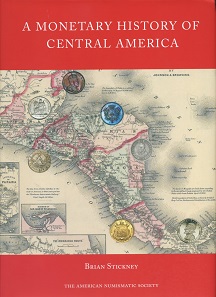by Ursula Kampmann
translated by Christina Schlögl
May 17, 2018 – I have a small library of no more than 8,000 books. And I repeatedly come across gaps regarding certain subject matters. If I need something on Central American numismatics for instance, I will not be able to find anything. I do not have a single special publication about the subject. This might also be because my Spanish is moderate to non-existent. It is for this reason that I am very happy that Brian Stickney’s book on the monetary history of the Central American states, published by the American Numismatic Society, is written in English.
Brian Stickney, A Monetary History of Central America. Numismatic Studies 35. The American Numismatic Society, New York 2017. 398 p., Fig. in black and white. 21 x 29 cm. Hardcover. ISBN: 978-0-89722-350-8. US$ 49.95.
For all those who, like me, stumble over their geographic knowledge: Central America refers to the states Guatemala, Honduras, El Salvador, Nicaragua, Costa Rica, Panama and Belize or British Honduras. In some periods of time, their histories cannot be strictly separated. The same applies to the numismatic history of Central America. It is thus only sensible to deal with these states at once and not just organise them geographically but mostly temporally.
Stickney thus starts with an opening chapter on their common Pre-Hispanic and Hispanic (numismatic) past; the next chapter examines their way to independence and provides an overview on the mutual coins of the United Provinces of Central America. It is only at this point that Stickney starts to geographically distinguish between the states in order to then talk about the failed attempts at a monetary union in the last chapter.
This very readable monetary history by Stickney has an optimal combination of explaining text passages and short catalogues. As a result, you can also use the book to classify coins! For this purpose, the author provides the subcategories coins (C for coins) and medals (M for medals) and attributes continuous numbers to them. Next to images – photos and drawings where appropriate – he provides the denomination, the ruler and the weight. Wherever possible he found out the mintage in order to filter out great rarities.
There is a fluent passage between text and catalogue. The author has added images of banknotes to create a well-rounded image of the monetary circulation.
We are thus grateful to Brian Stickney for this useful book. I would be happy to see more gaps in my library filled by books like this one.
You can order the book via the website of the ANS. Members will get a discount there. They will get the book for 49.95$ + shipping and packing.
Europeans can simply order the book via Oxbow.





